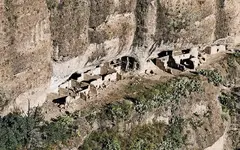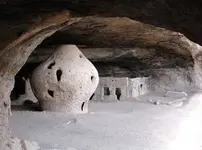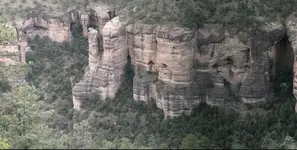comiliano had been a runner for Pablo Schmidt, a German, who was digging a mine at Sierra la Chuna, a three or four mile walk from San Bernardo. Sierra la Chuna was a small outlying mountain with oak, not high enough for pine. Schmidt was a rice grower in Ciudad Obregon and I had met him through Hoffman. One day I had Emiliano guide me up there when he was carrying supplies from the store in San Bernardo up to the mine for Don Pablo. I rented a horse from Don Juan Argiielles and rode while Emiliano walked. It was a nice trip up through the woods. We climbed up into the mountains and came to Pablo Schmidt's dig. He had another German fellow or two and some Mexicans working for him.
Schmidt was digging away down in a kind of hole there. He showed me an inscription on the rocks right above his dig. After I got acquainted with him, he told me he was digging for an Aztec treasure. He said he'd had the petroglyphs on the rocks interpreted by an anthropologist or linguist and they indicated that Aztec treasure was buried right there. So I found out about Don Pablo's treasure hunt. I told him that I was exploring, going up to the Rio Mayo country to see the Guarijfo Indians, and I hoped to get as far as San Luis Barbarocas.
He said, "Well, maybe I oughtn't to tell you this, but I think I will. If you're going up into that country, there's a lost mine up there called la Mina Tayopa which is famous for its rich ore." He said nobody else knew where it was, but that he'd give me the description of how to find it. Schmidt said to go to San Luis Barbarocas, climb the mountain north of the river, that the mine was a short distance below on the Rio Mayo. The miners used to come down to San Luis Barbarocas to get milk in the morning, so it couldn't have been more than a few miles away. There was supposed to be a cache up there mined by the Jesuits and abandoned when they left.
On your way up, you would see these three peaks and on the back side of the third peak you would find an iron door. If you could go through that iron door, you'd find the cache of gold and silver. "Well," Schmidt said, "don't try to bring it out by yourself. You'll get killed on the way. The people would all know you had it and you'd be robbed. Come back and notify us and we'll get it out." So Schmidt told me all about the Tayopa Mine. I finally got up to San Luis, and sure enough, there were three peaks up there. Maybe there's an iron door there too, but probably a tree has grown up since the Jesuits left in 1767.
I'd read about the mine in Carl Lumholtz, who had visited the mine. Old Dobie [J. Frank Dobie] had also written about looking for the Tayopa Mine. He apparently had never read Lumholtz. I never went beyond San Luis and didn't waste any time looking for the Tayopa Mine or the treasure, but I've always remembered Pablo Schmidt's secret directions to me. Schmidt never found any treasure there and finally abandoned his dig. Incidentally, San Luis Barbarocas was the farthest church founded by the Jesuits when they came into the Rio Mayo country. It was a very modest adobe church, but it was about twice as tall as any other building in the village and it had been kept intact. The roof had been patched and kept up, so it was still standing when I was there but it wasn't very much used. There were a few Indians, but no Mexican rancheros living in San Luis. I rode that old Nublado horse up to San Luis Barbarocas by myself one day and found an Indian hut. It started to rain, so I went into the hut. The Indian who lived there knew a little Spanish so I could talk to him. He took me out to the storehouse where he kept his grain, a little room with a porch about six feet long, and he said I could sleep under the porch. I slept under that porch in his corn crib that night and early the next morning I found out an old sow had crawled into bed with me. She'd come in out of the rain and laid down next to me. So that's the way I spent the night at San Luis Barbaroca..."rcourtesy of CUB"







 Naturally I had to question him. Jesus was tall, and wore a cloak, was beared, and of a clear complexion, that Jesus had stayed in his house. That one day JESUS said that he had to visit another pueblo some 13 miles away. IHe called the other pueblo by telephone tto let them prepare for his coming but the other stoped him cold by saying " But he is already here "
Naturally I had to question him. Jesus was tall, and wore a cloak, was beared, and of a clear complexion, that Jesus had stayed in his house. That one day JESUS said that he had to visit another pueblo some 13 miles away. IHe called the other pueblo by telephone tto let them prepare for his coming but the other stoped him cold by saying " But he is already here " 
